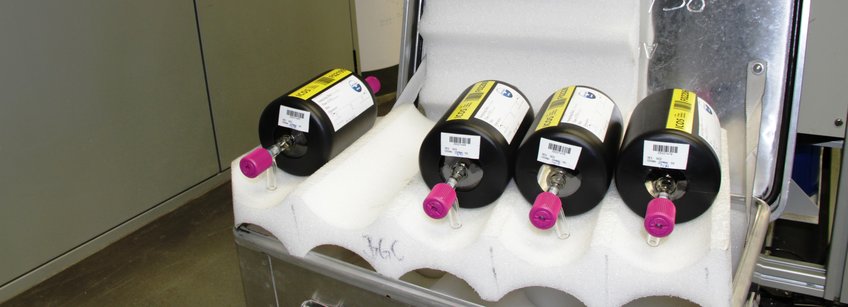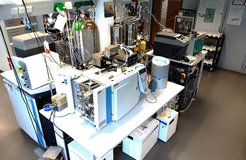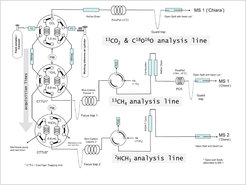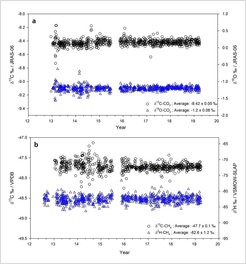
Isotopic analysis of atmospheric CH4 (δ13C and δ2H)
Simultaneous isotopic analysis of atmospheric methane and carbon dioxide

Methane is one of the most potent greenhouse gases. Its sources and sinks are not yet fully understood and isotopic analyses are a good tool to further our understanding in this regard. The BGC-IsoLab has developed the “integrated System for the Analysis of Air Constituents” (iSAAC; Brand et al., 2016). ISAAC is designed to analyse the carbon and hydrogen isotopic composition of atmospheric CH4, and the carbon and oxygen isotopic composition of atmospheric CO2 from one 1 liter sample flask (Figure 1).

A total of 200 ml of sample gas are needed to analyse all isotopes of CO2 and CH4. Samples are introduced and transferred through an intricate array of acquisition and analysis lines. Four atmospheric CO2 aliquots are taken during one sample aquisition and analysed against reference air on “Chiara”, the IRMS dedicated to isotopes of CO2. Throughout the same sample run CH4 is trapped cryogenically in two traps. The gas from one trap is oxidised to CO2 and and analysed on “Chiara”, while the gas from the other trap is pyrolised to H2 and analysed on “Diana” the IRMS dedicated to δ2H analyses. Details of the measurement principles can be found in Brand et al. (2016).

Isotopic measurements of atmospheric CO2 are standardised on the JRAS-06 scale (see JRAS). The measurement precision for δ13C and δ18O is usually better than 0.05 and 0.08 ‰, respectively. Hydrogen and carbon isotopic measurements of atmospheric CH4 are standardised against methane standards that have been developed in the BGC-IsoLab (Sperlich et al., 2016). The δ13C and δ2H isotopic composition of methane gas was analysed against primary standards by Element-Analysis- (EA-) and High-Temperature Conversion- (HTC-) isotope ratio mass spectrometry. These standardised methane gases were then mixed into methane-free air and used to calibrate the working standard gas that is used for iSAAC. Thus the δ13C isotopic results of methane are given on the δ13CVPDB scale, while the δ2H results are given on the δ2HVSMOW/SLAP scale. Long-term measurement precision for isotopes of methane is 0.1 and 1.2 ‰ for δ13C and δ2H, respectively .


